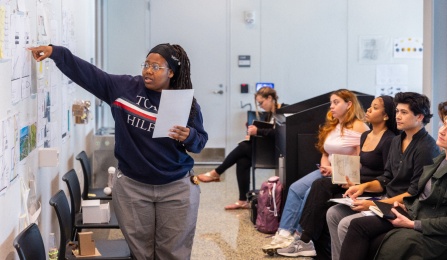Equity, Diversity, and Inclusion

Photo by Douglas Levere
Our Commitment to Inclusive Excellence:
The School of Architecture and Planning believes that fostering a culture of inclusion in our learning environments is essential for educating students, and we are committed to becoming a leader in equity, inclusion, and diversity. We strive to broaden the diversity of those who study, teach, research, and practice architecture and planning to ensure a wider variety of diverse needs will be met through those professions.
Admissions and Diversity Goals
Our student diversity goals significantly influence admission procedures by actively considering factors beyond just academic merit to build a student body that reflects a broad range of perspectives and backgrounds, ultimately aiming to create a richer learning environment for all students. This is achieved through holistic review processes where admissions officers evaluate applicants comprehensively, considering both quantitative data like test scores and qualitative aspects like essays and letters of recommendation to identify individuals who can contribute to diversity within our student body.

Students make presentation in an architecture class led by Jin Young Song. Lydie Rock T Numa presents. Photographer: Douglas Levere
Research on Equity, Inclusion, and Diversity:
Our school faculty and students work across disciplines, and with community partners, to break down barriers to equity and social justice. For example, our nationally-ranked research centers and faculty are developing solutions for more equitable food systems from Buffalo, NY to Kerala, India—advancing the health and wellbeing of vulnerable populations around the world. We are exploring historical “whiteness” that permeates our building disciplines, working to set international standards for inclusive design practices, driving new investment in low-income communities through community-engaged economic development planning, and developing adaptive design and planning solutions for populations experiencing the disproportionate impacts of climate change. Please see below for more information on our research centers with a focus on equity and inclusion.
Research Centers with a Focus on Equity and Inclusion:
Programs and Activities:
Our goals for inclusive excellence extend from our efforts to recruit a diverse student body (and therefore enhance diversity in our professions) to reinforce the success of students through a culture of meaningful commitment. Several programs and initiatives at the school advance these goals.
- UB Chapter of the National Organization for Minority Architecture Students: The mission of ubNOMAS is to champion diversity within the design professions by promoting the excellence, community engagement, and professional development of its members.
- African American Students of Architecture and Planning: In 2019, a network of African American students and students of African descent formed the African American Students of Architecture and Planning to facilitate engagement of underrepresented students with minority communities in the City of Buffalo.
- Architecture+Education: Sponsored by the Buffalo Architecture Foundation, the Architecture + Education program pairs graduate architecture students and practicing architects in the community with public school teachers to infuse architecture into the curriculum.